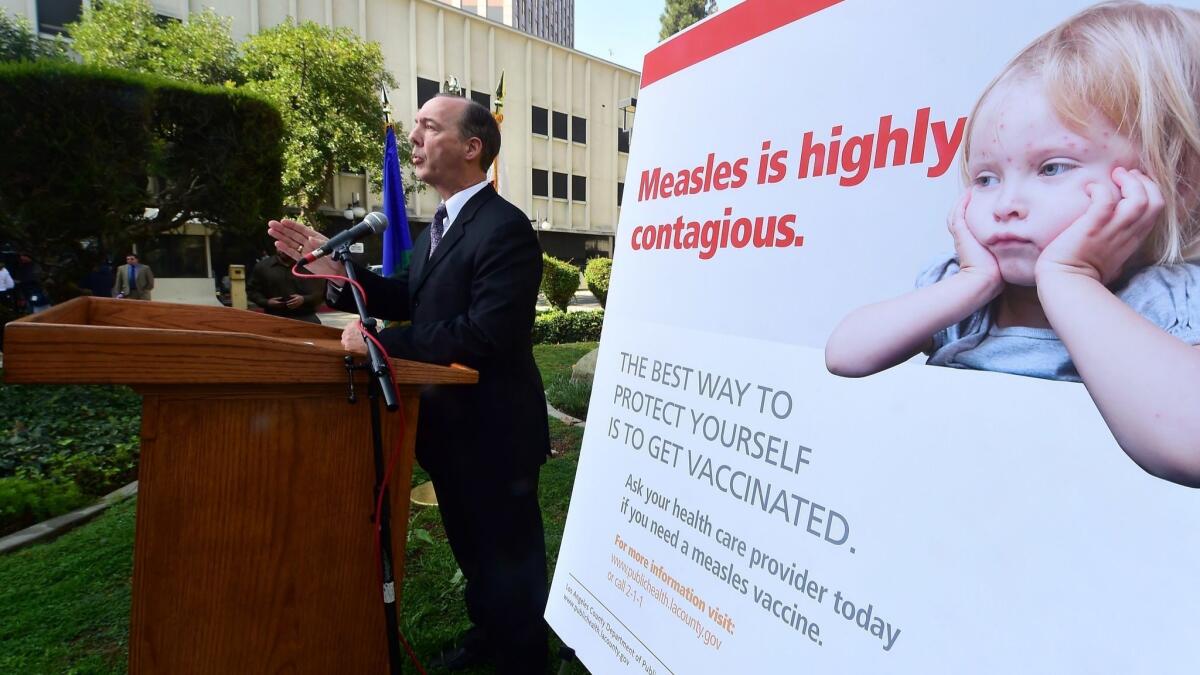Op-Ed: How doctors can help skeptical patients understand vaccines

- Share via
In 1853, as public health awareness was growing in England, Parliament passed a law requiring all babies to be vaccinated for smallpox, a virulent and deadly disease. The vaccine, developed by physician and scientist Edward Jenner at the turn of the previous century, was an effective way of preventing smallpox. Yet, not everyone was happy about the new law.
Pockets of resistance arose quickly, and in 1867, the National Anti-Compulsory Vaccination League was founded, with concerns not dissimilar to those of today’s vaccine skeptics. The group questioned whether the vaccine might harm its recipients; they believed doctors were somehow profiting from the vaccination law; and they railed against the absence of personal choice.
Today, with the measles epidemic, we are back, effectively, to where Brits found themselves in the 19th century. But there is one big difference. Then, there was incomplete knowledge of how diseases spread and how vaccinations prevent them. Now, the issue isn’t so much a lack of information but the lack of a proper foundation on which to process information. Doctors need to help provide that foundation for their patients.
Not long ago, the father of one of my pediatric patients asked me a simple question about vaccinations: “How is giving a medication to my healthy child supposed to be a good thing?”
It was a eureka moment for me to hear that he considered vaccines to be medicines rather than what they actually are: prevention tools. A vaccine needs to be seen more like a helmet or a seat belt — preventing something from happening rather than treating something that’s there. I tried to clarify how vaccines work by using an analogy. I asked him if he read aloud to his son. He did. I likened vaccines to what happens when he repeatedly points to and identifies an object in a favorite book. Over time, his son learns what the object looks like, and when he sees it in real life, he will recognize it.
A vaccine needs to be seen more like a helmet or a seat belt — preventing something from happening rather than treating something that’s there.
Similarly, a vaccine contains protein identifiers of the virus or bacteria it is aimed at preventing. It doesn’t have the complete virus or bacteria itself — just as a book has only a picture of, say, a zebra, not the actual animal. The immune system learns to “recognize” the identifiers, and is thus able to mount a strong response if and when it encounters the actual virus or bacteria, much as a child could recognize a real zebra in the zoo because of exposure to pictures of one.
Two other concepts doctors need to help their patients understand are causality and risk. Causality is tricky. In part, it’s a matter of timing. If your toe hurts immediately after you hit it against the door, it’s reasonable to assume the door caused it. But timing alone isn’t enough; there also must be plausibility — a rational reason to connect one thing with another. There is a rational reason, after years of study, to connect smoking to lung cancer, for example. But even though the symptoms of autism often first emerge in children at around the same age that they are being vaccinated, there’s no biologically plausible basis for a connection — any more than, say, than if a child who prefers to wear yellow every day develops autism, we could establish that yellow clothing caused the condition.
Similarly, and related to this, most of us are poor judges of risk and its role in how we process uncertainty. We fear dying in a plane crash more than in a car accident, though the latter is far more likely. With vaccines, hearing about a rare side effect, especially if coupled with an emotional element (having a close friend who shares the same fear, for example), can make the risk of being vaccinated seem far greater than the risks posed by the disease it would prevent, even though quite the opposite is true.
Enter the Fray: First takes on the news of the minute »
That said, it’s important for doctors to empathize with parents who express these fears. Whether or not a fear is fully rational, it’s real. One thing that can help is explaining not only the research behind vaccine risk, but also the rigor with which research articles are appraised and reviewed. It was that rigor that exposed, in the end, the fraudulent “research” that suggested a vaccine-autism connection. It was also scientific rigor over decades of meticulous research that has established the safety and efficacy of vaccines. And the inquiry doesn’t stop when a vaccine hits market. The Vaccine Adverse Event Reporting System is a U.S. government-sponsored safety surveillance program aimed at quickly spotting problems with vaccines. In the past, it has been able to rapidly identify potential problems, as it did with a first-generation rotavirus vaccine, for instance.
A final thing doctors might want to share with reluctant patients is something that I myself was surprised to learn: Vaccines are only a tiny fraction of pharmaceutical profit. So the argument in vaccine-hesitant communities that vaccines are promoted largely because they provide huge profits for drug companies simply doesn’t pan out.
Part of the reason there’s such a disconnect between physicians and vaccine-skeptical patients is that they don’t come into the discussion speaking the same language. The more we can learn about each others’ perspectives, the better it will be for children and for public health.
Amitha Kalaichandran is a resident physician and writer based in Ottawa, Canada. Twitter and Instagram: @DrAmithaMD.
More to Read
A cure for the common opinion
Get thought-provoking perspectives with our weekly newsletter.
You may occasionally receive promotional content from the Los Angeles Times.










